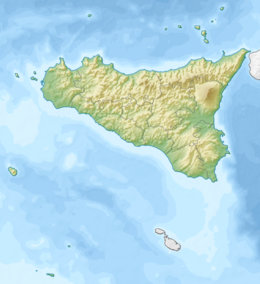Lampione
This article needs additional citations for verification. (December 2009) |
 | |
 | |
| Geography | |
|---|---|
| Location | Mediterranean Sea |
| Coordinates | 35°33′06″N 12°19′18″E / 35.551647°N 12.321665°E |
| Archipelago | Pelagie Islands |
| Area | 0.036 km2 (0.014 sq mi) |
| Length | 200 m (700 ft) |
| Width | 180 m (590 ft) |
| Highest elevation | 36 m (118 ft) |
| Administration | |
Italy | |
| Region | Sicily |
| Province | Agrigento |
| Comune | Lampedusa e Linosa |
| Demographics | |
| Population | uninhabited |
Lampione (Italian pronunciation: [lamˈpjoːne];[1] Sicilian: Lampiuni, English: Lantern) is a small rocky island located in the Mediterranean Sea, which belongs geographically to the Pelagie Islands and administratively to the comune of Lampedusa e Linosa, Province of Agrigento, region of Sicily, Italy. It is about 200 metres (656 feet) long and 180 metres (591 feet) across, and has an area of 4 hectares (9.9 acres) and a highest elevation of 36 metres (118 feet).
The islet is uninhabited, the only building being a lighthouse. According to the legend, the island was a rock which had fallen from the hands of the cyclops Polyphemus.[2]
Lampione is part of the Riserva Marina Isole Pelagie, and its vegetation and wildlife are strictly protected. Animal species include the endemic Podarcis filfolensis ssp. laurentimulleri (also found on Linosa), which is a subspecies of Maltese wall lizard, numerous migrating birds, and the Armadillidium hirtum pelagicum, a land crustacean. The waters are populated by sharks, including the sandbar shark, groupers, lobsters, and varieties of yellow and pink coral.
See also
References
- ^ Luciano Canepari. "Lampione". DiPI Online (in Italian). Retrieved 15 January 2020.
- ^ "Le isole più inaccessibili". fanpage.it. Retrieved April 21, 2018.

